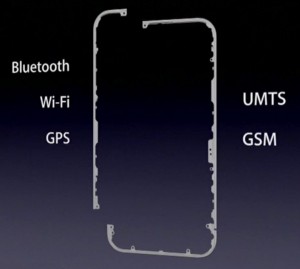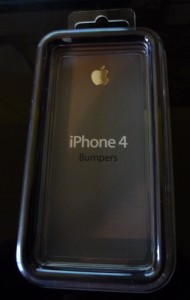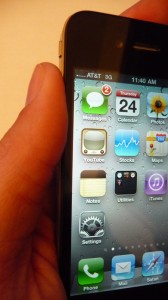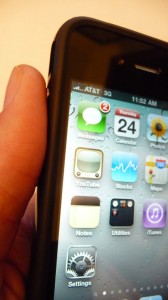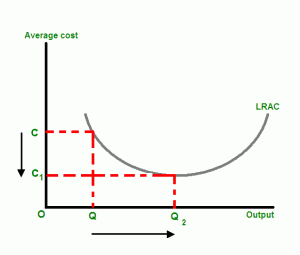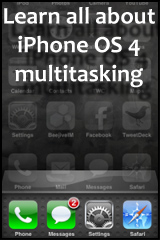The answer to why some don’t see the iPhone 4 bars drop in their left hand
by Justin Horn on Jun 30th, 2010 @ 10:39 am Image from Anandtech
Image from Anandtech
The short answer…it does, you just don’t see it in “the bars”.
I first thought this could be the answer way back on the June 24th during my bumper testing:
I then tested in another room with less electronics. In this room I started with a strong signal of 5 bars. This time around, with or without the bumper, the signal held pretty much at 5 bars. This may explain why some people don’t seem to notice this issue. If you have really great AT&T service where you live, the in hand signal drop may not be as noticeable.
After reading John Gruber’s post backing up my idea, I did a more specific follow up post on the issue:
I think the problem is “the bars”. They serve their purpose for the most part, but when trying to do a test involving signal strength we need more detail. I would argue that 5 bars in one area is not necessarily equal to 5 bars in another. Start with a “weak 5 bars” and you can see the signal loss represented by the bars dropping. Start with a “strong 5 bars” and the signal may be getting weaker, but never below the 5 bar threshold. In this case it appears to the user that they still have the same signal strength and it goes unnoticed.
Turns out the “not all 5 bars are created equal” was dead on. It was hard to prove this before because the old field test app that showed these numbers was removed from iOS 4. That didn’t stop Anandtech though, with a neat hack job they were able to get the numeric signal number back on iOS 4 instead of the bars:
However, you can see just how little dynamic range iOS 4 has for reporting signal; over 40% of the range of possible signal levels (from -99 dB to -51 dB) is reported as 5 bars.
They go on to test the drop in signal by how it’s held:
Tight grip in hand: 24.6 dB
Holding naturally in hand: 19.8 dB
Holding naturally with case: 7.2 dB
Open palm: 9.2 dB
Now let’s revisit my bars and bumper test with the dB numbers provided by Anandtech:
Strong 5 bars (Naturally held)
You start with the strong 5 bars at -60 dB (-51 dB would be strongest 5 bars), then you hold it in your left hand, lowering the signal to -79.8 dB (-51 dB – 19.8 dB). Even though you have a significant drop in signal, it’s still above the -99 dB threshold for 5 bars, so it goes unnoticed in the bars. If you did a speed test before and after, you would be able to see the difference…try it.
Weak 5 bars (Naturally held)
You start with the weak 5 bars at -90 dB (-99 dB would be weakest 5 bars), then you hold it in your left hand, lowering the signal to -109.8 dB (-90 dB – 19.8 dB). This now takes you past the 1 bar threshold of -107 dB. With 1 bar you can still make calls, but have a better chance of a drop. The bigger issue, at least for me, is the 3G data speeds drop dramatically.
Bumper (Naturally held with case)
I know I was starting with a signal that was on the lower end of 5 bars because every once in a while it would drop down to 4 bars. For this example let’s assume it was -95 dB. Holding naturally with the bumper it would drop down to -102.2 dB (-95 dB – 7.2 dB) putting it in the 3 bar range, exactly what I got during my test.
Another way to think about it in terms of bars would be to add 5 more bars on top of the 5 that already exist. Not as an average, but just adding more detail to the high end. The user that claim they don’t have an issue are really starting out with 9-10 bars in this 10 bar and dropping to 5-6, but those that start with 5 are dropping to 1.
So those of you that were counting yourself lucky are just starting off better, but when you aren’t holding your phone you still have a stronger signal.
Follow me on Twitter @justin_horn
Can’t link your Nike+ sensor to your new iPhone 4? No voice updates? Stops recording run? Here’s the fix
by Justin Horn on Jun 29th, 2010 @ 3:29 pm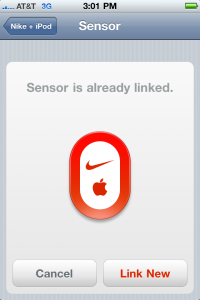
I started having some issue with Nike+ on my iPhone 3GS running the iOS 4 betas and even still on the GM. They weren’t show stoppers, but pretty annoying:
- Not getting verbal updates most of the time when pressing the home button
- After stopping to refill my water bottles on long runs, Nike+ clock kept running but would stop counting miles. This would happen if I paused the workout or just left it running
I just accepted the loss of verbal updates and would just end / begin a new workout well it stopped tracking miles. I was excited to try my luck with the iPhone 4 yesterday, but I couldn’t even get it to find my shoe sensor. No matter what the Nike+ app wouldn’t detect my sensor and had to fall back to using my old 3GS.
UPDATE The fix below may also resolve the other issue I mentioned above in addition to just syncing the sensor.
The Fix
After contacting @NikePlus I was told to do a general iPhone settings reset, reset the phone, and try again.
1) Settings > General > Reset (all the way at bottom) > Reset All Settings. This will not remove any data or mess up any stored passwords for apps and such.
2) After the iPhone boots back up, restart it again. To do this press and hold the lock button on the top of the phone and then press and hold the home button…do not let go until you see the black screen with the Apple logo.
3) Once the iPhone boots back, go to Settings > Nike + iPod and click on Sensor to try syncing it again. You may also need to give the little button on the bottom of the sensor a series of quick presses.
The first time I tried the above I still couldn’t connect. So I left the Nike+ settings and returned the home screen. I then pressed the little button a few more times, went back into Nike+ settings, threw the sensor back in my shoe and gave the sync another try. This time around it worked! Hopefully this get’s it going for you as well.
Also, according to reply I received from @NikePlus, Nike and Apple are aware of ALL the issues I’ve highlighted here (included the 3GS ones):
Thanks for the feedback. We and Apple are aware that some users are having both problems. Hoping for a quick fix!
Please keep in mind that Apple is control of creating the app for Nike+, as it requires more access than a standard third party app. So don’t blame Nike, there is nothing they can do directly. They can only work with Apple to get it resolved.
Follow me on Twitter @justin_horn
View 78 Comments
Featured post, iOS 4, iPhone, iPhone 4, Nike+, Tips
Further investigation into the iPhone in hand signal issues
by Justin Horn on Jun 24th, 2010 @ 8:12 pmI looked into how the bumper case affected the signal loss problem earlier. It helped lessen the signal loss, but still lost a couple bars. I’ve been thinking about this issue all day and decided to dig a bit deeper to see what I could find.
UPDATE For those of you that don’t have this issue, my best guess…I wrote earlier today in my bumper case post:
I then tested in another room with less electronics. In this room I started with a strong signal of 5 bars. This time around, with or without the bumper, the signal held pretty much at 5 bars. This may explain why some people don’t seem to notice this issue. If you have really great AT&T service where you live, the in hand signal drop may not be as noticeable.
Watch the video of this phenomena.
Gruber agrees with this and here is my post explaining it in more detail.
Read the rest of this awesome article
Follow me on Twitter @justin_horn
View 12 Comments
Antenna Issue, Featured post, iPhone 4, Speculation
Bumpers help prevent iPhone 4 signal drop
by Justin Horn on Jun 24th, 2010 @ 12:13 pmUPDATE The final answer on how the signal is affected in hand vs in case.
After some tests this morning, it looks like the bumper case helps with the antenna issue we reported on yesterday. Keep in mind that I used the main 5 bar signal indicator as a reference, not sure how to get into field test mode on the iPhone 4. Also, as the signal can change anytime, for any reason, the results were not always the same. I just kept repeating (many times) the test and this was what I got on average.
No Bumper
Hands off: 4-5 bars
In hand: 1 bar
With Bumper
Hands off: 4-5 bars
In hand: 3 bars
So the bumper did keep the signal at 3 bars compared to it plummeting to 1 bar shortly after picking up the naked iPhone.
I then tested in another room with less electronics. In this room I started with a strong signal of 5 bars. This time around, with or without the bumper, the signal held pretty much at 5 bars. This may explain why some people don’t seem to notice this issue. If you have really great AT&T service where you live, the in hand signal drop may not be as noticeable.
Check out this video of this strong signal room.
The fact that the signal still dropped down to 3 bars even with the bumper on and that I saw no drop in the “strong signal room”, leads me to believe that a software update to boost the output power (like we got in the 3.x days) may help resolve the issue. Apple said a software patch was coming, so I guess we won’t have to wait long to find out…when will iOS 4.0.1 be released?
Follow me on Twitter @justin_horn
Is the new iPhone 4 antenna design causing signal issues?
by Justin Horn on Jun 23rd, 2010 @ 6:25 pmUPDATE Add me to the list, same problem! Got a bumper though, hopefully it helps. …and it does seem the bumpers help though. Further investigation into the iPhone in hand signal issues.
When I first heard of the new antenna system on the iPhone 4, I thought it would increase the signal by getting the antenna out from behind all the other electronics. It later crossed my mind that by actually touching the antenna, with conductive skin, it could cause a weaker signal. I figured Apple wouldn’t have gone with this design if it was a problem, so the thought left my mind.
Things changed today…I’m hearing reports from a few different users that this is actually an issue. Not a big enough sample group to call it a major issue, but we should find out soon enough tomorrow when a ton more iPhone 4s hit the street.
Jeremy Sikora tweeted to let us know that Apple is claiming it’s a software issue. When I asked where he heard that and if there was an official press release he replied:
@justin_horn no but WM talked about same issue in his review. Apple claimed a software patch is coming.
NOTE: Jeremy isn’t just some random guy on Twitter, when he says something Apple related he is usually correct.
In response to our tweet earlier about the issue a little while ago, Loyal Moses tweeted:
Same Problem!
Loyal posted some videos of the problem on his blog.
Joe Wilcox tweeted earlier:
iPhone 4 first impression: Delightful device. Network sucks worse. I had better 3G on iPhone 3GS. “Searching” frequently.
Later, Joe Wilcox confirms this is an issue:
@justin_horn LOL, my mistake. Flat down on my desk, I see full bars. I hold the phone in my palm, bars slowly go down, like video.
Further evidence is one user who posted a video of the issue in action
Gizmodo is all over this, guess they are mad they didn’t get a test unit
(via @tarungangwani)
Follow me on Twitter @justin_horn
Economy of scale
by Justin Horn on Jun 17th, 2010 @ 1:06 pmFrom Wikipedia:
Economies of scale, in microeconomics, are the cost advantages that a business obtains due to expansion. They are factors that cause a producer’s average cost per unit to fall as scale is increased.
These three words sum up why we will not see a Verizon iPhone until 4G LTE is a reality.
Before we get into economies of scale, just think about how many hours of R&D go into the development of the iPhone every year. To make a custom iPhone for one carrier, in one country, seems like a wasted expense. Don’t get me wrong, I’m sure they have looked at or even done some limited R&D on what it would take to get a CDMA iPhone out the door, but it’s not a main focus.
Take the R&D expense out of the equation and the Verizon iPhone still doesn’t make sense. As Apple’s manufacturing partners ramp up production of the iPhone, the cost per unit is going to drop and Apple’s profit will go up.Why would they want to have a production line just for Verizon? Verizon is a huge company, but compared to AT&T and the rest of the world, they aren’t. They would have to make far fewer CDMA iPhones raising the average cost and cutting into their profits.
Continued from Wikipedia on Economies of scale:
Economies of scale may be utilized by any size firm expanding its scale of operation. The common ones are purchasing (bulk buying of materials through long-term contracts), managerial (increasing the specialization of managers), financial (obtaining lower-interest charges when borrowing from banks and having access to a greater range of financial instruments), and marketing (spreading the cost of advertising over a greater range of output in media markets).
I highlighted purchasing and marketing as these are the main factors that would influence Apple. They’ve put strains on world supplies of flash chips due to the huge production of their latest iDevices, so we know they can get some bulk buying discounts. To build the Verizon iPhone they would need to purchase CDMA chips on a much smaller scale increasing their cost. The marketing might overlap a bit, but they would need to tweak ads to make sure they didn’t advertise a feature, like talk and surf, as Verizon’s CDMA network can’t support this.
Go beyond the cost of the manufacturing and think about supporting the phone. This is one reason why Apple only makes one iPhone per year, compared to Motorola’s and Nokia’s hundreds.
What about that special Chinese iPhone? In this case all Apple had to do was disable WI-FI. I’m not an Apple engineer, but common sense tells me disabling a feature is monumentally easier than swapping out the main radio chip that makes up the phone part of iPhone. I’m betting the WI-FI chips are still in there and disabled via the hardware. As for support, it’s the same phone with one featured disabled, so one less thing to break.
What about AT&T’s generous early upgrade policy this year? You’ll remember last year they did almost the same thing, but only extened the upgrade elgible window through September. This year they only exteneded it an additional 3 months. The other difference this year is AT&T raised the ETF from $175 to $350 on all their smartphones, matching Verizon’s somewhat recent ETF rate hike. I know some make a case that these two events mean they are trying to get more people hooked on AT&T with a bigger penalty for leaving. It’s very logical argument, but I just think they raised the ETF to match Verizon and are offering the early upgrade to iPhone owners for the same reasons as last year.
We will see an iPhone on Verizon when Verizon is on the same wireless network technology as the rest of the world. This will happen when everyone goes to the 4G LTE networks. When the 4G network will be deployed on a large scale is another question. I’ve heard rumors of 2011, but something tells me we are still a 2-3 years away.
Follow me on Twitter @justin_horn

